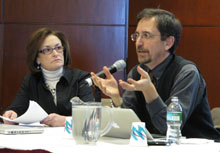
February 4, 2010 — The first of three Shorenstein Center/Belfer Center seminars on news coverage of climate change, “The Public Divide over Climate Change: Scientists, Skeptics and the Media,” was itself a lively debate.
The panel featured Andrew C. Revkin of the New York Times‘ Dot Earth blog, Matthew Nisbet of American University, and Tom Patterson of the Shorenstein Center, and was moderated by Cristine Russell of the Belfer Center.
Russell started the discussion by sketching out what made climate change such a challenging issue to cover: As traditional media have downsized, space devoted to science gets cut back. The issue is complex and discussions of solutions don’t fit neatly in sound bites. While a majority of the public believes that climate change is a genuine problem, skeptics are grabbing more attention using “climategate” as a lever. And people are distracted by issues that hit close to home, the economy in particular.
Revkin compared public opinion to “a big chunk of water in a shallow pan. You get a lot of sloshing, but not a lot of depth.” He felt that the issue of climate change will never be in the top five of the public’s concerns — “I’d be willing to put some decent money on that,” he joked — in part because “it’s not as simple as one would like or feel.”
“We’re in a world now where it’s easy to send information back and forth, to share ideas, to debate,” Revkin said, “but the synthesis, the sense of where you go through that overabundance of information, that is the open question.” He believed that given changes in the mainstream media, “information has to come from outside the thing called journalism.”
Nisbet said that some of the consequences have been positive. “Scientists have become more focused on public engagement,” he noted, and went on to discuss two dimensions of climate change he felt could raise public awareness: public health and national security. “They shift impacts from remote locations to close locations,” Nisbet said, and constituted “an opening to move across the ideological divide.”
Tom Patterson began his remarks by citing Herbert Hyman and Paul Sheatsley’s classic 1947 article, “Some Reasons Why Information Campaigns Fail,” then listed recent statistics that give little hope for clarity in the climate-change debate: That before the invasion of Iraq, a slight majority of Americans thought Saddam Hussein and Al-Qaeda were in league. That only 26 percent of Americans knew that it takes 60 Senate votes to break a filibuster. That many believe Hillary Clinton — not Harry Reid — is the Senate majority leader. “From this, we can turn to the media, and ask the media to do a better job of reporting, but this is a monumental task,” Patterson said.
In looking for a possible way forward, Revkin recounted a trip that he took to Istanbul for a story on the risk of earthquakes in megacities — “This was before Haiti,” he noted. There he meet children in a poor area of the city who didn’t have computers, yet knew about Facebook because they had access in a community center.
“If there was a perfect translation interface for Facebook, we don’t need Esperanto. The technology of the Web, in an instant, maybe next week, will facilitate the global conversation, in ways that transcend journalism,” Revkin said. “You can start to have a truly global sense of neighborhood. I do think it’s worth at least experimenting on.”
This article was written by and the photos taken by Leighton Walter Kille of the Shorenstein Center.

